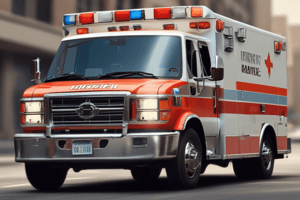Podcast
Questions and Answers
What is a primary disadvantage of ground transport in EMS?
What is a primary disadvantage of ground transport in EMS?
- It can transport multiple critical patients simultaneously.
- It does not require extensive personnel.
- It has long transport times and relies on intact infrastructure. (correct)
- It offers a high level of on-scene care.
When managing a high acuity call, what is the role of CFRs in patient care?
When managing a high acuity call, what is the role of CFRs in patient care?
- To transport all patients to a local hospital.
- To establish online medical control for all patients.
- To always follow standing orders without exception.
- To provide additional resources for ALS crews. (correct)
In what situation is air transport particularly advantageous?
In what situation is air transport particularly advantageous?
- It offers greater patient capacity than ground transport.
- It requires less infrastructure compared to ground transport. (correct)
- It can quickly transport multiple non-critical patients.
- It is not affected by weather conditions during operations.
What is a common misconception regarding patients and EMS protocols?
What is a common misconception regarding patients and EMS protocols?
What are some capabilities of receiving facilities in a disaster context?
What are some capabilities of receiving facilities in a disaster context?
What defines the levels of care in EMS?
What defines the levels of care in EMS?
What is an essential factor in managing mass gatherings effectively in EMS?
What is an essential factor in managing mass gatherings effectively in EMS?
What is the role of online medical control in EMS operations?
What is the role of online medical control in EMS operations?
What is the primary focus of the Certified First Responder (CFR) training?
What is the primary focus of the Certified First Responder (CFR) training?
Which of the following skills is NOT typically taught in EMT-Basic training?
Which of the following skills is NOT typically taught in EMT-Basic training?
What distinguishes EMT-Intermediate/Advanced training from EMT-Basic training?
What distinguishes EMT-Intermediate/Advanced training from EMT-Basic training?
What is a critical aspect of EMT-Paramedic training?
What is a critical aspect of EMT-Paramedic training?
Which statement about Critical Care transport teams is accurate?
Which statement about Critical Care transport teams is accurate?
How has the nature of emergency calls changed with the advent of cell phones?
How has the nature of emergency calls changed with the advent of cell phones?
What is the role of the Emergency Medical Dispatcher when EMS is activated?
What is the role of the Emergency Medical Dispatcher when EMS is activated?
Which of the following is NOT a level of EMS personnel?
Which of the following is NOT a level of EMS personnel?
Flashcards are hidden until you start studying
Study Notes
EMS Overview
- Emergency Medical Services (EMS) provides out-of-hospital care and can respond to disasters or mass gatherings.
- Activation of EMS typically occurs when someone dials 911, although not all regions in the U.S. have this service.
Staffing
- EMS personnel are categorized into different roles: Certified First Responder (CFR), Emergency Medical Technician (EMT), and Paramedic (PM).
- Training levels include Basic, Intermediate/Advanced, and Critical Care.
Certified First Responder (CFR)
- Requires 40 hours of training focused on supportive care until transport arrives.
- Skills include oxygen administration, hemorrhage control, CPR, and AED certification.
EMT-Basic
- Involves 120 hours of training, emphasizing basic life support.
- Skills covered: hemorrhage control, non-invasive airway adjuncts, ventilation, splinting, and immobilization techniques.
- Certifies in CPR and AED.
EMT-Intermediate/Advanced
- Builds upon EMT-Basic training, requires additional coursework.
- Capabilities include starting IVs, limited IV fluid administration, and placing advanced airways (varies by state).
- Can administer limited medications like Naloxone and Dextrose.
EMT-Paramedic
- Involves over 2000 hours of training, with some programs offering associated degrees.
- Requires prior certification as an EMT-B.
- Focus areas include ECG, ACLS training, advanced airway placement, and critical interventions for cardiac events, strokes, and invasive procedures.
Critical Care
- Specialized for transferring critically ill or injured patients between facilities.
- Typically involves a team of EMT-P, Registered Nurse, and Respiratory Therapist operating specialized equipment.
- Transport options include rotary air, fixed wing, and ground.
Communication and Resource Management
- 911 calls are directed to Emergency Medical Dispatchers who assess needs and dispatch resources.
- Enhanced access through cell phones has increased the speed of response but can complicate logistics.
- Patient care guided by standing orders and protocols, with reliance on online medical control for additional guidance.
Transport Methods
Ground Transport
- Strengths: Readily available, can transport multiple non-critical patients.
- Weaknesses: Long transport times and dependence on local infrastructure.
Air Transport
- Strengths: Operates independently of ground infrastructure, offers high-level on-scene care.
- Weaknesses: Limited capacity, requires more personnel, and is weather-dependent.
Special Situations
- Planning and resource mobilization are crucial for mass gatherings and disaster medicine.
- Ideal scenarios include pre-established medical infrastructure, such as during the Boston Marathon with trauma centers and ER readiness.
Key Takeaways
- All EMS procedures revolve around timely pre-arrival instructions and efficient care.
- Multiple levels of care are vital: CFR, EMT-B, EMT-I/A, EMT-P, and Critical Care Paramedic.
- Effective communication and planning are paramount for successful EMS operations in emergencies.
Studying That Suits You
Use AI to generate personalized quizzes and flashcards to suit your learning preferences.




